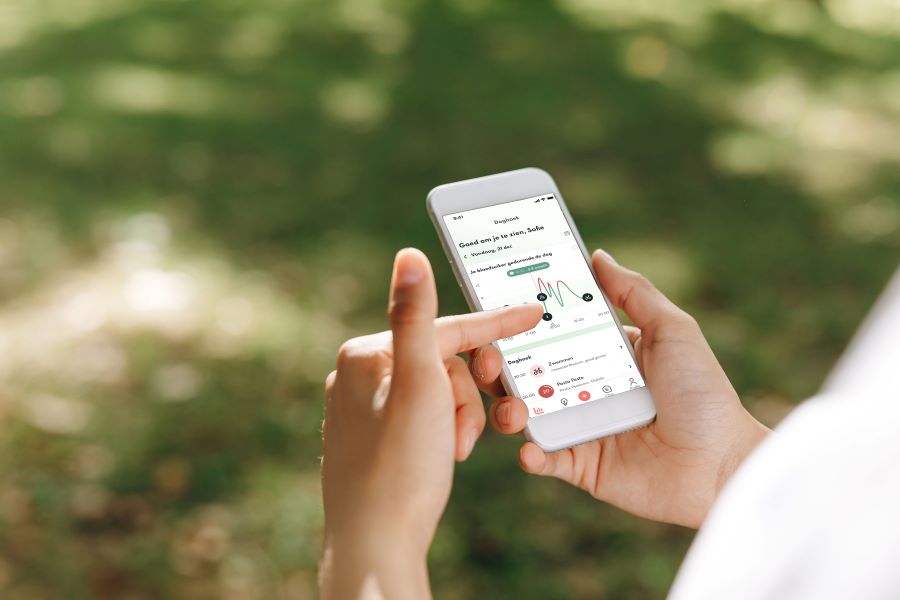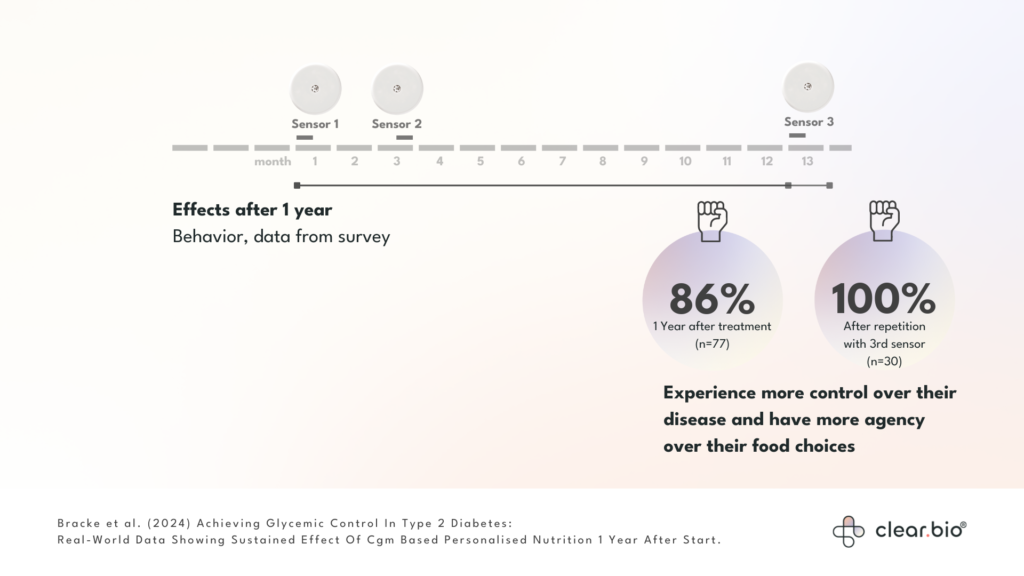9,2
/10
customer satisfaction

The effects of the 12-week treatment with Clear.bio in primary care are evident; 75% of patients lower their HbA1C, 62% of practice nurses (POHs) engage in different conversations with the patients, and 85% of POHs report a positive impact on patient behavior.
But are these effects sustainable? CSO Madelon Bracke and her team investigated the long-term effects of Clear.bio’s 12-week nutritional intervention, one year after the treatment initiation in the Eat-Measure-Know study in collaboration with the Eindhoven University of Technology and Amsterdam University Medical Center.
The results are impressive; personalized dietary advice, based on a smart app and periodic use of CGM, aids patients with type 2 diabetes in self-managing their glycemic control. The effects on behavior and glucose regulation are sustainable and still present one year after the intervention.
Meanwhile, patients from the Rotterdam and Breda regions are successfully referred through chain care. Interested in what Clear.bio can mean for your patients or organization? Or curious about all the study results? Request a personal and non-committal information session here.

94% still applies the insights after a year. The advice that sticks best is personalized advice (53%). The strength of Clear.bio lies in the combination of various digital features that promote self-management. Data visualization, actionable tips, and personalized dietary advice, along with interaction with a dietitian, result in more effective interventions and better health outcomes, as recently described in the scoping review by Mannoubi et al.

More than 2 out of 3 participants (69%) can reduce their average daily glucose levels by an average of 1.69 mmol/l over 12 weeks through the use of Clear.bio. Frequently asked questions about Clear.bio include: can the patient maintain this improvement? And how long does the effect last?
Therefore, a year after completing the Clear.bio treatment, a sensor was reinstalled in 30 participants. At the start of this 3rd sensor, we observe that an impressive 63% still have lower blood glucose levels than when they started Clear.bio.
This is very encouraging news. As suggested and researched by Philips et al. in 2014, the natural course of diabetes can be altered (slowed) without a rebound effect when the intervention is discontinued. Achieving normal glucose levels, even temporarily, is associated with a significant reduction in subsequent diabetes development.
For two-thirds of Clear.bio users, this would mean a one-year delay in the progression of their diabetes symptoms.

One year after completing treatment with Clear.bio, 86% still report having more control over their condition and agency over their food choices compared to when they started treatment. The perceived control increases to 100% when participants undergo a refresher treatment with a 3rd sensor (n=30).
This is accompanied by a lower reported stress level, higher well-being scores, and user satisfaction compared to the start of the treatment (not shown in the figure).
People with diabetes often experience stress and emotional problems, factors that can lead to poor adherence to therapy and glycemic control, negatively impacting quality of life. Understanding, education about, and control over the condition can contribute to better self-management and an improved quality of life.(^4,5)

One year after completing the treatment with Clear.bio, 40% of participants have been able to further reduce their glucose levels independently, without using a sensor and/or Clear.bio. For 61%, a ‘refresher’ with Clear.bio one year after treatment leads to further reduction or new improvement in glucose levels. The average reduction in HbA1c one year after starting treatment is -15 mmol/mol.(^9)
Recent reviews and meta-analyses have shown that individuals with type 2 diabetes are able to improve their glucose levels with an average HbA1c reduction of 3.5 mmol/mol when they use a continuous glucose monitor (CGM) for three months. The same result can be achieved when they follow a digital diabetes management program for three months.(^6,7)
In the first part of the EMW study(^8), we demonstrated that the Clear.bio treatment for three months leads to a 3x greater improvement; an average reduction of 11.6 mmol/mol. In the Clear.bio treatment, we utilize a continuous glucose monitor, visualization of the effect of nutrition in the app, and personalized and actionable advice.
These numbers suggest that (periodically) using a sensor in combination with very concrete and applicable nutrition and lifestyle advice for type 2 diabetes can result in a significant treatment effect at the time and ensure that the learning sticks and becomes routine.
Applying insights in daily life leads to more self-management and long-term health effects that are not necessarily dependent on a CGM or a diabetes management program. One year after treatment, a ‘refresher’ may still lead to further or new improvement in glucose levels for 61% of users. The total reduction in HbA1c compared to the start of treatment is on average -15 mmol/mol.
With the increase in the prevalence of Type 2 Diabetes Mellitus (T2DM), the healthcare system is under pressure. Medication treats the symptoms but not the underlying causes of diabetes. A lifelong dependence on medication and the development of complications lead to a heavy workload for healthcare providers and high treatment costs. Lifestyle intervention offers a powerful approach to halt disease progression at an earlier stage, considering:
The objective of the Eten-Meten-Weten Follow-up was to assess the long-term effects one year after completion of the 12-week personalized nutrition intervention. The 12-week personalized nutrition intervention, based on periodic use of CGM, leads to improved glucose regulation in 69% of participants with (pre)T2DM and to perceived disease control in 88% of participants.

Lifestyle intervention offers a powerful approach to halt and treat the disease progression of type 2 diabetes early. Lifestyle advice is therefore also the first step in the treatment plan for type 2 diabetes patients according to the NHG guideline.
Would you like to know what Clear.bio can mean for your patients or organization? Or are you curious about all study results? Request a personal and non-committal information session here.
